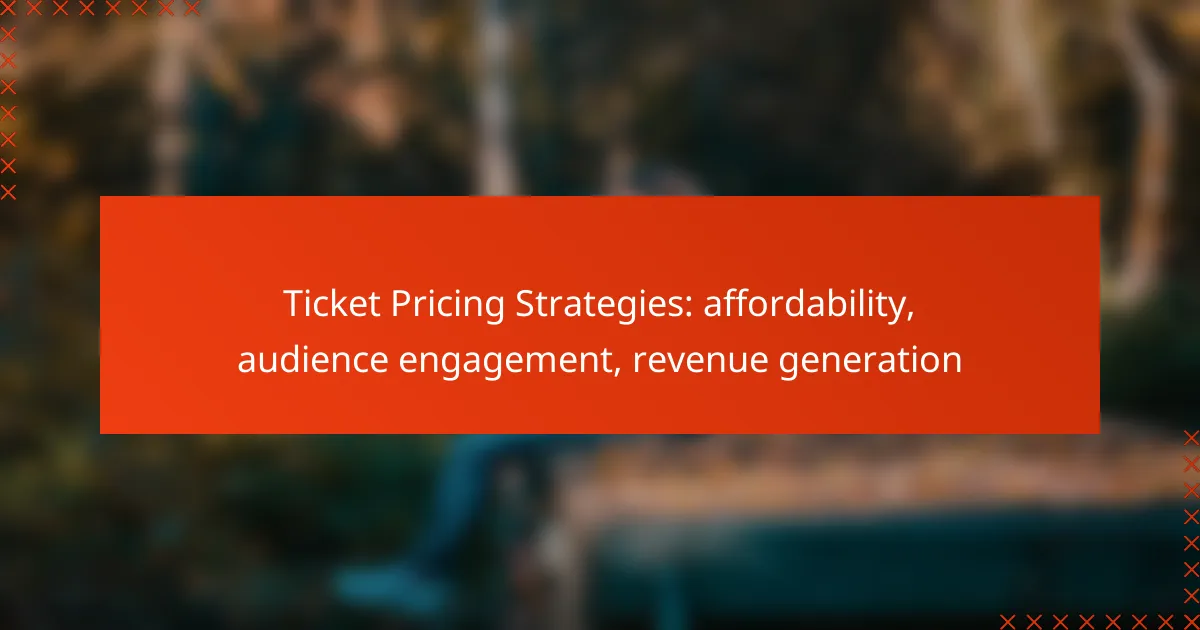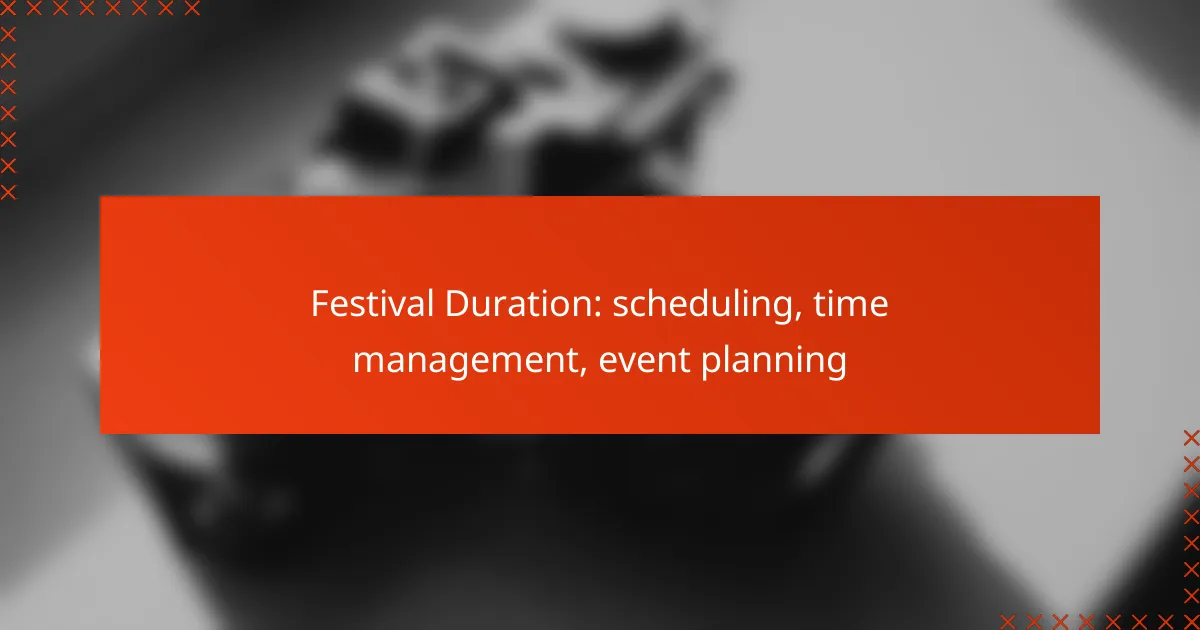Effective ticket pricing strategies play a vital role in enhancing affordability and accessibility for diverse audience segments in Australia. By understanding audience engagement and tailoring pricing accordingly, organizations can not only boost attendance but also optimize revenue generation, ensuring a win-win for both event organizers and attendees.
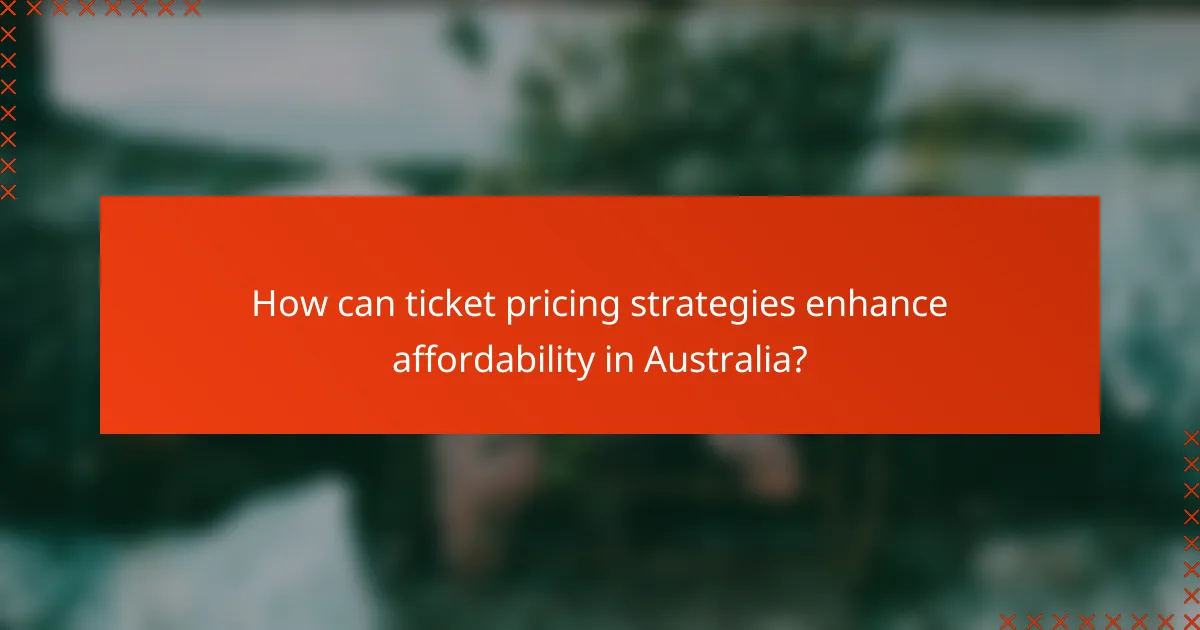
How can ticket pricing strategies enhance affordability in Australia?
Ticket pricing strategies can significantly improve affordability in Australia by offering various options that cater to different audience segments. These strategies not only make events more accessible but also encourage higher attendance rates, ultimately benefiting both organizers and attendees.
Dynamic pricing models
Dynamic pricing models adjust ticket prices based on demand, time, and other factors. This approach allows for lower prices during off-peak times, making events more affordable for budget-conscious consumers. For example, a concert might offer cheaper tickets in the weeks leading up to the event if sales are slow.
Consider implementing tiered pricing where early buyers pay less, while last-minute purchasers face higher costs. This strategy can maximize revenue while still providing options for those who plan ahead.
Discounted group rates
Offering discounted group rates can make attending events more affordable for families, friends, or organizations. Typically, discounts range from 10% to 30% off the standard ticket price when purchasing a certain number of tickets together.
To encourage group attendance, consider setting a minimum number of tickets required for the discount. This not only boosts sales but also fosters a sense of community among attendees.
Early bird pricing
Early bird pricing rewards customers who purchase tickets well in advance, often providing significant savings. This strategy can lead to increased cash flow for event organizers and allows attendees to secure their spots at a lower cost.
Establish a clear timeline for early bird rates, typically available several weeks to months before the event. Communicate these deadlines effectively to maximize participation.
Flexible payment options
Flexible payment options, such as installment plans or buy-now-pay-later services, can enhance affordability by allowing attendees to spread the cost over time. This approach can be particularly appealing for higher-priced events, making them accessible to a wider audience.
When implementing flexible payment methods, ensure that the terms are clear and straightforward. Consider partnering with reputable payment providers to offer these options seamlessly during the ticket purchasing process.
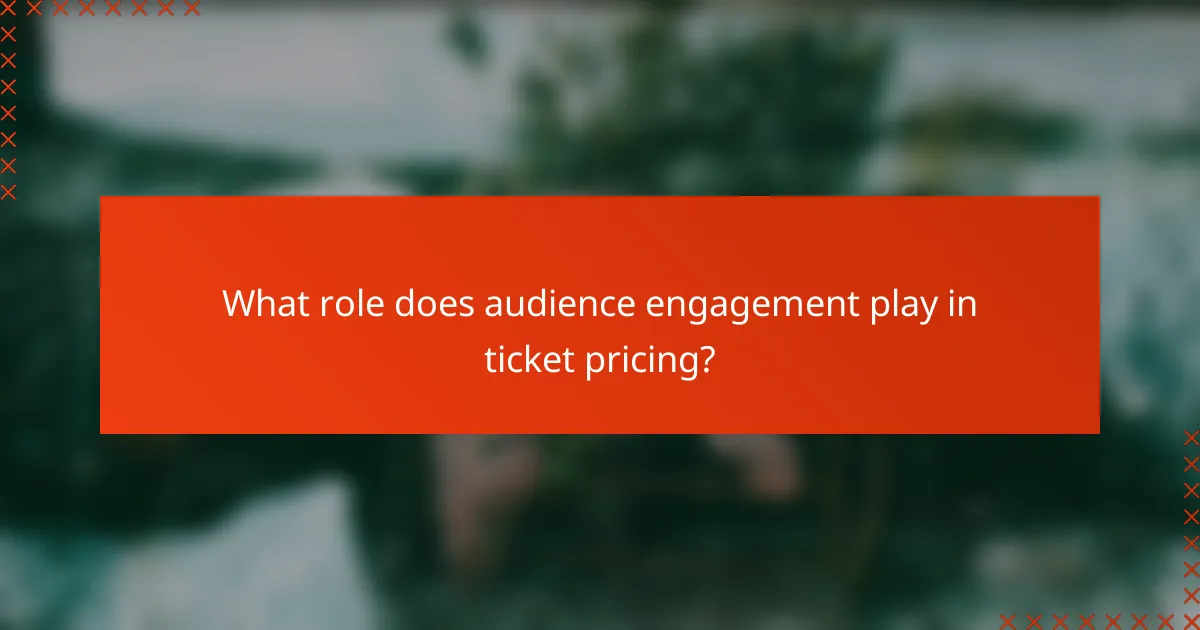
What role does audience engagement play in ticket pricing?
Audience engagement is crucial in ticket pricing as it directly influences how much customers are willing to pay. Engaging with potential attendees helps organizations tailor their pricing strategies to meet audience expectations and maximize revenue.
Personalized pricing strategies
Personalized pricing strategies involve adjusting ticket prices based on individual customer data and preferences. By analyzing past purchase behavior and demographic information, organizations can offer tailored pricing that resonates with specific audience segments. For instance, offering discounts to students or early bird specials can enhance engagement and drive ticket sales.
Implementing personalized pricing requires a robust data collection system and a clear understanding of customer segments. Organizations should consider using CRM tools to gather insights and automate pricing adjustments based on customer profiles.
Loyalty programs and rewards
Loyalty programs incentivize repeat attendance by offering rewards such as discounts, exclusive access, or points redeemable for future events. These programs not only enhance audience engagement but also encourage customers to commit to purchasing tickets more frequently. For example, a theater might offer a loyalty card that provides a free ticket after a certain number of purchases.
When designing a loyalty program, ensure that the rewards are appealing and achievable. Consider tiered rewards that motivate customers to reach higher levels of engagement, which can lead to increased ticket sales and a loyal customer base.
Interactive pricing feedback
Interactive pricing feedback allows audiences to express their willingness to pay through surveys or dynamic pricing models. By gathering real-time data on customer preferences, organizations can adjust prices to better align with audience expectations. This approach can be particularly effective for events with variable demand, such as concerts or sports games.
To implement interactive pricing feedback, consider using online platforms that facilitate audience input. Regularly analyze feedback to refine pricing strategies and enhance overall engagement, ensuring that ticket prices reflect the perceived value of the experience offered.

How can ticket pricing drive revenue generation?
Ticket pricing can significantly enhance revenue generation by strategically aligning prices with audience segments and perceived value. By implementing various pricing strategies, organizations can optimize sales, increase engagement, and maximize profits.
Tiered pricing structures
Tiered pricing structures involve offering tickets at different price points based on features, seating locations, or access levels. This approach allows organizations to cater to various audience segments, from budget-conscious attendees to those willing to pay more for premium experiences.
For example, a concert might offer general admission tickets at a lower price while providing VIP packages that include backstage access or exclusive merchandise. This strategy can help capture a broader audience and increase overall revenue.
Premium experience upsells
Premium experience upsells involve offering additional services or enhancements that attendees can purchase alongside their tickets. This could include options like early entry, meet-and-greet opportunities, or exclusive merchandise bundles.
By providing these upsell options, organizations can enhance the overall experience for attendees while generating additional revenue. For instance, a theater could offer a dinner package with a show ticket, appealing to those looking for a complete night out.
Partnerships with local businesses
Forming partnerships with local businesses can create additional revenue streams through cross-promotions and bundled offers. Collaborating with restaurants, hotels, or transportation services can enhance the overall experience for attendees while benefiting both parties financially.
For example, a sports team could partner with a nearby hotel to offer discounted accommodation packages for fans attending games. This not only drives ticket sales but also encourages local tourism and supports the community.
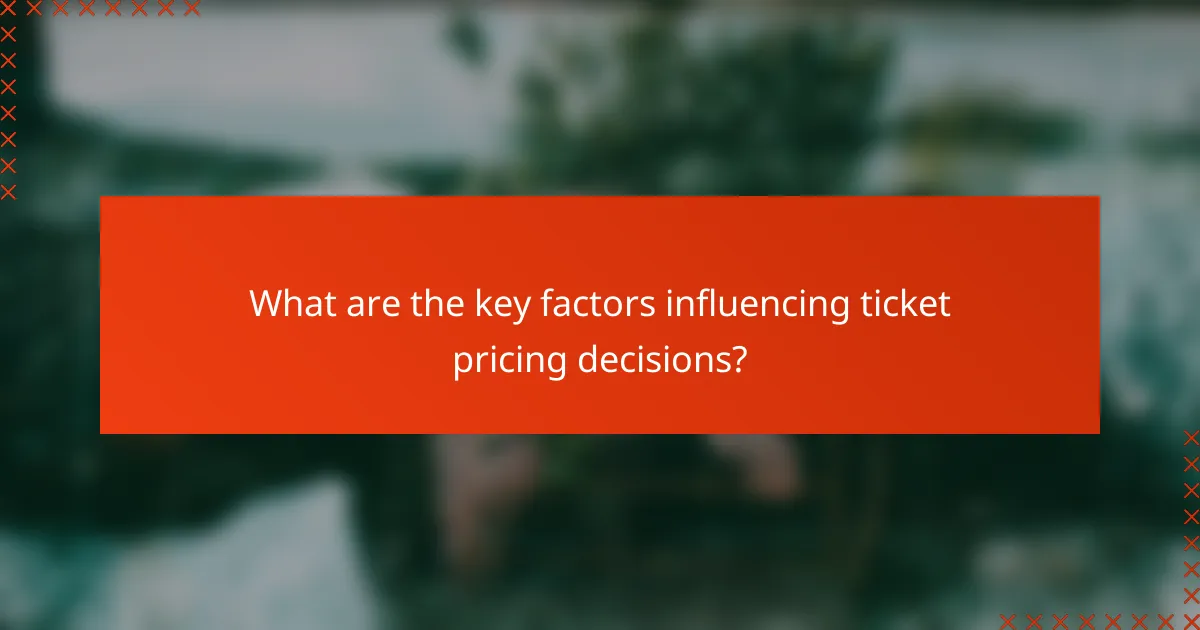
What are the key factors influencing ticket pricing decisions?
Key factors influencing ticket pricing decisions include market demand, competitor pricing, event type, and venue capacity. Understanding these elements helps organizations set prices that maximize revenue while ensuring affordability and audience engagement.
Market demand analysis
Market demand analysis involves assessing how many tickets potential attendees are likely to purchase at various price points. This can be done through surveys, historical sales data, and social media engagement metrics. Analyzing demand helps in identifying optimal pricing strategies that align with audience expectations.
For example, if a concert has high demand, prices can be set higher, while events with lower interest may require discounts or promotions. Tracking trends and adjusting prices accordingly can significantly impact overall ticket sales.
Competitor pricing strategies
Competitor pricing strategies refer to the analysis of how similar events are priced in the market. Understanding what competitors charge for similar experiences allows organizations to position their pricing effectively. This can involve setting prices slightly lower to attract more attendees or matching competitor prices to maintain perceived value.
Regularly reviewing competitors’ pricing, especially during peak seasons, can provide insights into market positioning. Organizations should avoid underpricing, which can devalue the event, or overpricing, which may deter potential attendees.
Event type and venue capacity
The type of event and the capacity of the venue play crucial roles in determining ticket prices. Larger venues can often accommodate more attendees, allowing for lower ticket prices due to higher volume sales. Conversely, intimate settings may justify higher prices due to exclusivity and a unique experience.
For instance, a major sports event in a stadium may have a wide range of ticket prices based on seating location, while a small theater production may have a more uniform pricing structure. Understanding the dynamics of the event type and venue capacity helps in crafting a pricing strategy that appeals to the target audience while maximizing revenue potential.
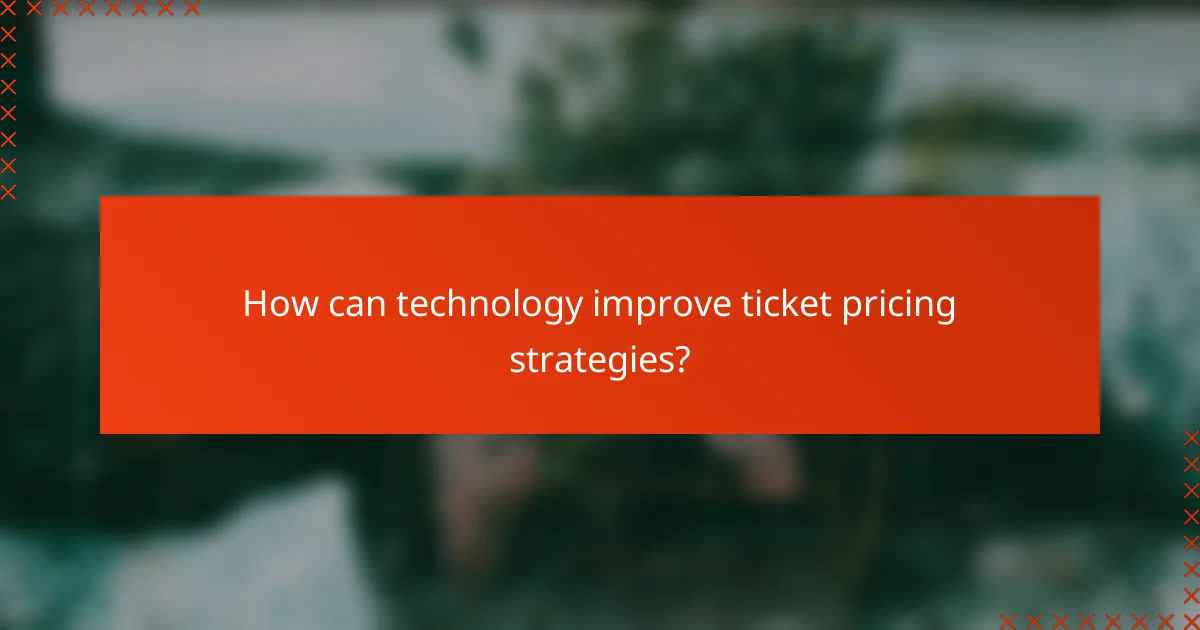
How can technology improve ticket pricing strategies?
Technology enhances ticket pricing strategies by leveraging data and automation to set optimal prices, engage audiences, and maximize revenue. By utilizing advanced tools, organizations can make informed decisions that align with market demand and consumer behavior.
Data analytics for pricing optimization
Data analytics plays a crucial role in optimizing ticket pricing by analyzing historical sales data, customer demographics, and market trends. This information helps organizations identify peak demand periods and adjust prices accordingly to maximize sales.
For example, a concert venue might analyze ticket sales from previous events to determine the best pricing tiers. By offering early bird discounts or dynamic pricing during high-demand periods, they can increase both attendance and revenue.
Mobile ticketing solutions
Mobile ticketing solutions streamline the purchasing process, making it easier for consumers to buy tickets on-the-go. This convenience can lead to increased sales, as potential attendees are more likely to complete purchases when they can do so quickly from their smartphones.
Additionally, mobile platforms can facilitate last-minute ticket sales by sending notifications about price drops or availability, further engaging the audience. Ensuring that mobile ticketing is user-friendly and secure is essential for maintaining customer trust and satisfaction.
AI-driven pricing algorithms
AI-driven pricing algorithms analyze vast amounts of data in real-time to adjust ticket prices dynamically based on demand, competition, and other factors. These algorithms can help organizations respond swiftly to market changes, ensuring that ticket prices reflect current conditions.
For instance, a sports team might use AI to increase ticket prices as a game approaches sell-out status, while lowering prices for less popular matches. Implementing AI requires careful consideration of the technology’s integration with existing systems and the potential impact on customer perception.
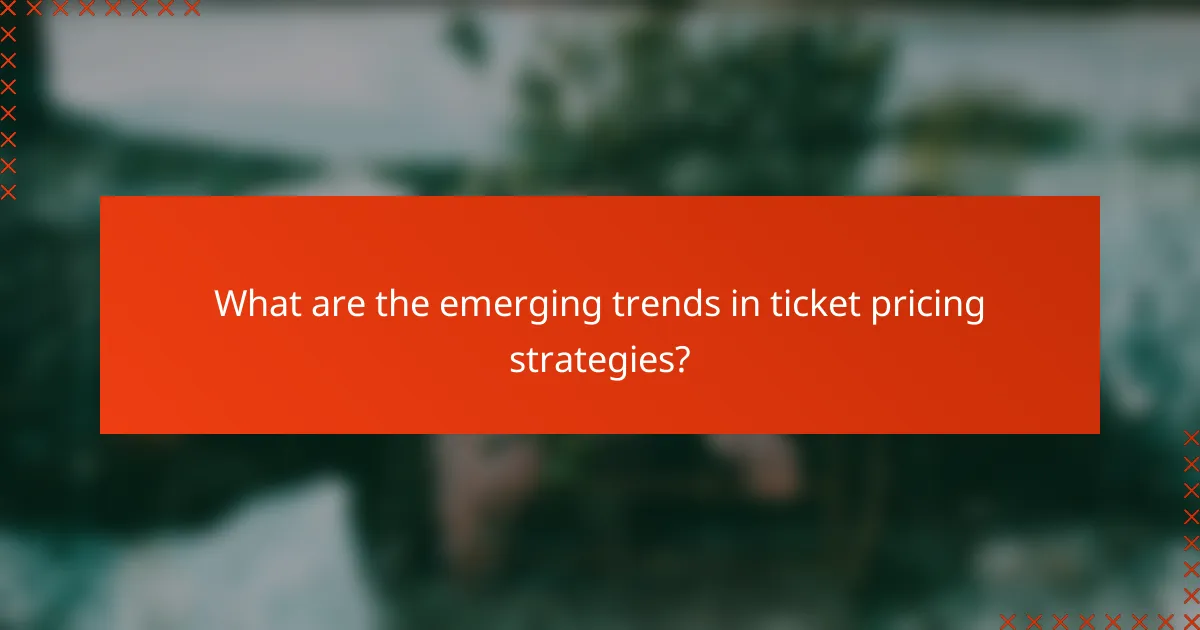
What are the emerging trends in ticket pricing strategies?
Emerging trends in ticket pricing strategies focus on balancing affordability, audience engagement, and revenue generation. These strategies leverage data analytics, dynamic pricing, and personalized offers to optimize sales and enhance customer experience.
Dynamic Pricing
Dynamic pricing adjusts ticket prices in real-time based on demand, time, and other factors. This approach allows organizations to maximize revenue by charging higher prices during peak demand and offering discounts during slower periods.
For example, a concert may have ticket prices that increase as the event date approaches or as more tickets are sold. This strategy can lead to increased sales and better inventory management, but it requires careful monitoring of market conditions.
Tiered Pricing Models
Tiered pricing models offer different price levels based on seating location, amenities, or access to exclusive experiences. This strategy caters to various audience segments, allowing fans to choose options that fit their budget and preferences.
For instance, a sports event might offer general admission tickets at a lower price while premium seats come with a higher price tag. This model can enhance audience engagement by providing more choices and encouraging upselling opportunities.
Subscription and Membership Models
Subscription and membership models provide fans with ongoing access to events for a fixed fee. This strategy fosters loyalty and encourages repeat attendance, as members often receive exclusive benefits such as early access to tickets or discounts.
For example, a theater might offer a monthly subscription that allows members to attend multiple shows at a reduced rate. This approach can stabilize revenue streams and build a dedicated audience base.
Personalized Pricing and Offers
Personalized pricing and offers use data analytics to tailor ticket prices and promotions to individual preferences and behaviors. This strategy enhances customer satisfaction and can lead to higher conversion rates.
For instance, if a customer frequently attends a specific genre of events, they might receive targeted discounts for similar shows. This approach requires robust data collection and analysis but can significantly improve audience engagement.
